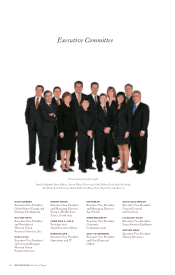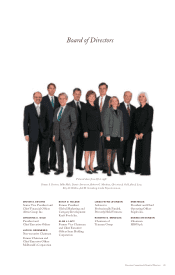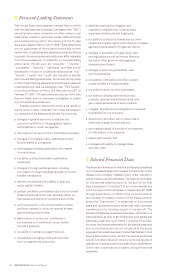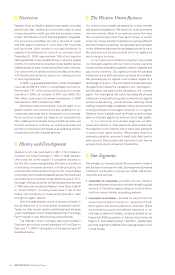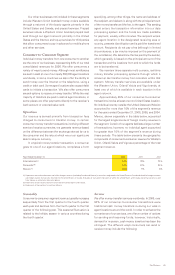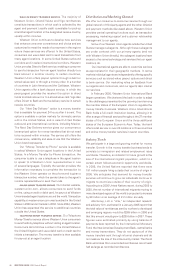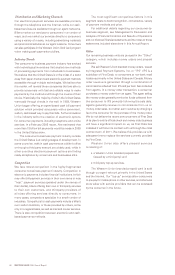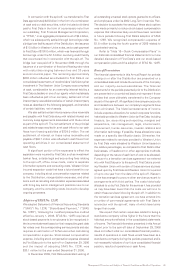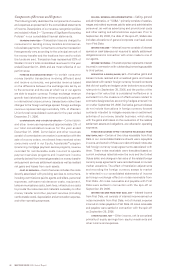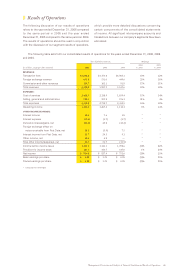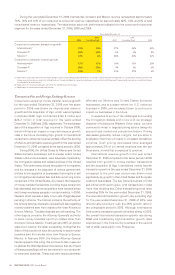Western Union 2006 Annual Report Download - page 40
Download and view the complete annual report
Please find page 40 of the 2006 Western Union annual report below. You can navigate through the pages in the report by either clicking on the pages listed below, or by using the keyword search tool below to find specific information within the annual report.WESTERN UNION 2006 Annual Report 38
Distribution and Marketing Channels
Our electronic payment services are available primarily
through the telephone and the Internet, while our cash-
based services are available through our agent networks.
Billers market our services to consumers in a number of
ways, and we market our services directly to consumers
using a variety of means, including advertising materials
and promotional activities at our agent locations. Consumers
can also participate in the Western Union Gold Card program
when making cash payments to billers.
Industry Trends
The consumer-to-business payment industry has evolved
with technological innovations that created new methods
of processing payments from individuals to businesses.
We believe that the United States is in the midst of a trend
away from paper checks toward electronic payment methods
accessible through multiple technologies. We believe that
the market will reward those companies that are able to
provide consumers with fast and reliable ways to make
payments by the method and through the means of their
choice. Historically, the majority of bills in the United States
were paid through checks in the mail. In 1989, Western
Union began offering an agent-based cash bill payment
solution which provided consumers with a convenient,
walk-in, cash-based way to pay their bills. Further innovation
in the industry led to the creation of electronic options
for consumer payments including telephone and online
services. In a February 2005 report, Aite estimated that
more than 18 billion bill payments would be made in 2005
in the United States alone.
The consumer-to-business payment industry outside
the United States is at varying stages of development. In
some countries, walk-in cash payments at a biller’s office
or through a third party network are widely used, while in
other countries electronic payment options are finding
ready acceptance by consumers and businesses alike.
Competition
We face robust competition in the highly-fragmented
consumer-to-business payment industry. Competition in
electronic payments includes financial institutions (which
may offer bill-payment services in their own name or may
“host” payment services operated under the names of
their clients), billers offering their own or third-party services
to their own customers, and third-party providers of
all sizes offering services directly to consumers. In
many cases, competitors specialize in a small number of
industries. Competitors for cash payments include a biller’s
own walk-in locations, or those provided by others, some
only on a regional basis, as well as mail and courier services.
There is also competition between electronic and cash-
based payments methods.
The most significant competitive factors in this
segment relate to brand recognition, convenience, variety
of payment methods and price.
For additional details regarding our consumer-to-
business segment, see Management’s Discussion and
Analysis of Financial Condition and Results of Operations
and our historical financial statements and the notes to those
statements included elsewhere in this Annual Report.
Other
Our remaining business units are grouped in the “Other”
category, which includes money orders and prepaid
services.
We sell Western Union branded money orders, issued
by Integrated Payment Systems, Inc. or “IPS” (IPS is a
subsidiary of First Data), to consumers at non-bank retail
locations primarily in the United States and Canada. Money
order revenue is generated through a combination of
commissions collected from IPS and per item fees collected
from agents. In a money order transaction, a consumer
purchases a money order from an agent. The agent selling
the money order generally remits the funds collected from
the consumer to IPS promptly following the sale date.
Agents generally receive no commissions from us on
money order sales, but rather earn revenue by charging a
fee to the consumer for the purchase of the money order.
We do not believe the recent announcement of First Data
of its plan to exit its official check and money order business
will have a significant impact on us, as First Data has
indicated it will honor its contract with us through the initial
contract term of 2011. We believe this provides us with
adequate time to replace the services currently provided
by First Data.
Western Union also offers prepaid services
consisting of:
|| a Western Union branded prepaid card
(issued by a third party); and
|| third-party top-up services.
The Western Union branded prepaid card is sold
through our agent network primarily in the United States
and the Internet. Our “top-up” services allow consumers
to pre-pay for mobile phone or other services, and otherwise
store value with service providers that can be accessed
by the consumer in the future.




